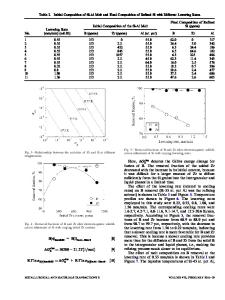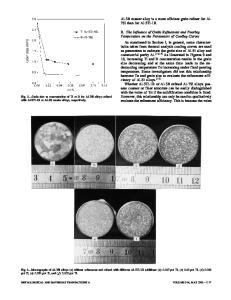Grain refinement of copper by the addition of iron and by electromagnetic stirring
- PDF / 1,963,088 Bytes
- 7 Pages / 614.28 x 794.28 pts Page_size
- 79 Downloads / 286 Views
I.
INTRODUCTION
THE importance
of fine equiaxed grains as opposed to columnar grains has long been recognized in a casting. Among various enhanced properties associated with a fine grain structure are improved low-temperature strength, reduced anisotropy, formability, and reduced segregation scale. The latter is especially important in castings that have to undergo homogenization; in a fine grain structure the characteristic diffusion distance and hence the homogenization time is reduced compared to a coarse grain structure. A number of techniques have been developed to produce fine grain structures during solidification. ~ The most common method is to add small amounts of grain refining agents, inoculants, to the melt just prior to casting. The additions either go into solution or remain as solids that act as heterogeneous nucleation catalysts during solidification. Examples of grain refining agents employed commercially for various alloys have been given in a recent review article by Mondolfo. 2 It is commonly accepted that the effectiveness of a grain refining agent is either due to enhanced heterogeneous nucleation rate or due to a reduction in the growth rate of the existing grains, thus allowing for further nucleation. However, the actual mechanism of grain refinement and hence the criteria which determine the effectiveness of one addition vs another are not fully understood. In general, the requirements for a good nucleating agent are higher interfacial energy between the inoculant and the melt, compared to that between the nucleated solid and the melt, and a good epitaxial fit between low index planes of the inoculant and the solid) In addition, the inoculant particles should be stable at the melt temperature, and should not agglomerate or float. A lower degree of lattice mismatch between the nucleant and the solid has been suggested as a possible criterion to determine grain refining potency of an inoculant. 4 In the absence of accurate surface energy data,
J. A P A T C H E T T , a Graduate R e s e a r c h A s s i s t a n t , and G J ABBASCHIAN, Professor, are with the Department of Materials Scxence and Engineering, University of Florida, Gainesvtlle. FL 32611 Manuscript submitted November 29, 1984.
METALLURGICAL TRANSACTIONS B
Youdelis s has suggested the use of the "nucleation entropy" as a criterion for grain refining effectiveness. Based on this criterion, the larger the nucleation entropy, the more effective is the grain refiner. The solute build-up ahead of the solid-liquid interface, proposed by Tarshis et al. ,6 is another criterion for evaluating effectiveness of alloy additions. According to this criterion, the greater the solute build-up ahead of the interface, the more effective is the alloy addition in promoting grain refinement. Grain refining via peritectic reactions is another well known technique that is commercially employed in various alloys, especially in aluminum based alloys. 7'8 The grain refining techniques discussed above involve the deliberate addition of alloying elements
Data Loading...










